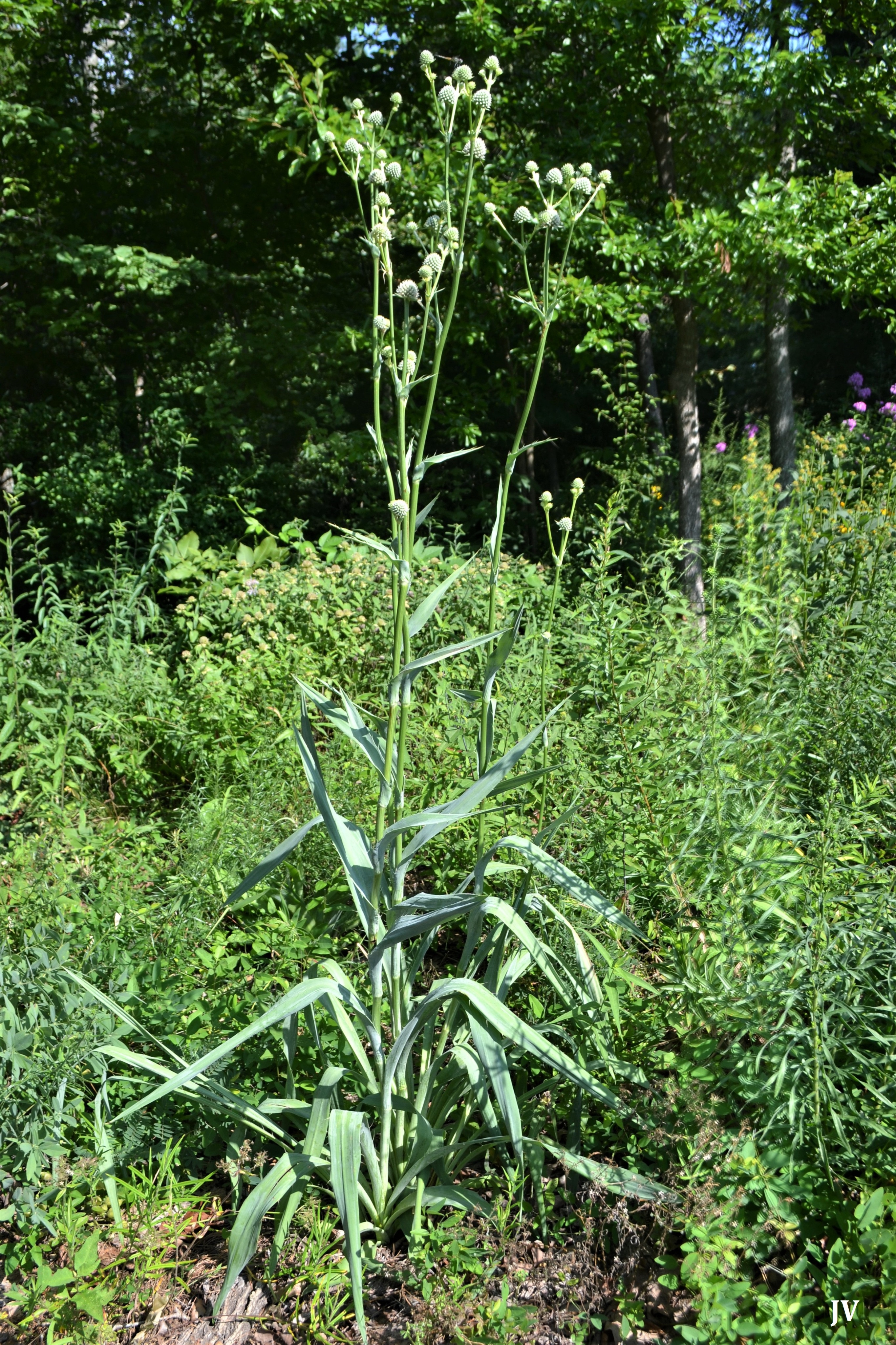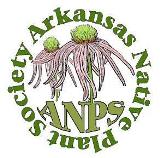Rattlesnake Master (Eryngium yuccifolium) of the Parsley or Carrot (Apiaceae) family is a tall perennial with distinctive ovoid flower heads. The genus name is based on the ancient Greek name used by Theophrastus for a prickly plant of the Mediterranean region. The specific epithet is Latin for “yucca-leaved”––morphologically true, although the two groups are unrelated: despite its strap-shaped, parallel-veined, monocot-looking leaves, Rattlesnake Master is a dicot. The common name is based on use of the plant by Native Americans to treat snakebites, for protection from being bitten, or for controlling snakes during ceremonies. In the U.S., the species grows principally from eastern Texas north into Iowa and east to Indiana, North Carolina, and Florida. In Arkansas, it occurs statewide. Habitats vary from sunny to partially shaded prairies, savannas and open woodlands, to stream banks and roadsides, in a broad variety of dry to wet soils. It is also known as Button Eryngo.

The glabrous (hairless) plants may have ropy roots only (observed in well-drained sandy soils) or corms and ropy roots (observed in wet soils). With ropy roots only, at shallow depth, roots radiate from the base of the stem, lacking a taproot. Corms, when present, grow to 2 inches long and ¾ inch wide, typically decaying after several years. These near-surface tan to brown corms have descending ropy roots attached to the base of stems or along the lower side of the corms. Individual corms bear a stem or two. At the end of the growth year, stems die and drop off, leaving round scars on the corm’s upper surface with rough end scars marking where the older corm rotted away. With clonal corms increasing in number over the years, a dense cluster of plants may develop.


Leaves and stems decline at the end of the growing season (August) as new basal rosettes appear and persist over winter. In late winter, stems begin to grow from the basal rosettes. In more favorable sites, stems may grow to 5+ feet tall. The round, pale green stems have alternate, cyclically arranged leaves separated by ½ inch near the base to 12 inches distally. Stems are straight, stout, smooth, and hollow between the nodes (fistulose).

Leathery, strap-like basal and stem leaves are pale green to bluish green, usually with a waxy, white coating (glaucous) on both surfaces. Venation is parallel, without a notable midrib. Larger leaves have widely spaced, weak marginal spines with fine tips, ½ to ¾ inch long near the leaf base. Stem leaves, arranged cyclically, with broad, clasping bases grow to 3 feet long and 1 to 1¾ inches wide. Basal leaves tend to decline as the stem continues to grow.

The stem terminates in a flower head. Along the upper portion of the stem, 1-5 lateral branches bear additional terminal heads, with some stems containing as many as 20+ heads on stout, straight peduncles.

Flowering occurs in late June into August. The primary inflorescence consists of heads with 90± tiny (3/16 inch long, 2/16 inch wide) densely packed flowers (morphologically, the heads are condensed umbels) in which the sessile flowers are attached to a spongy core (the receptacle). Each flower is subtended by a triangular pointed bract (floral bract). The upright heads, ¾ to 1 inch wide and high, are subtended by elongate-triangular overlapping basal bracts. Floral bracts and basal bracts have firm pointed tips so that the heads feel prickly.

The perfect flowers (with pistils and stamens) have 5 sepals, 5 petals, 5 stamens (filaments + anthers), and 1 compound pistil (ovary + styles + stigmas) of 2 carpels. Greenish white sepals and white petals are attached at the top of the ovary––the ovary is “inferior,” the flowers “epigynous.” The white styles (obscurely tipped with stigmas) appear several days to a week before the stamens. The white hair-like filaments, twice as long as the styles, hold the relatively large, tan, 2-lobed anthers well above the corolla.




With fertilization, flowers produce a schizocarp-type fruit which splits into 2 dry, indehiscent, 1-seeded mericarps (a diagnostic feature of the parsley family). The obovate mericarps have a flattened interior side and two exterior sides which are densely scaly with persistent sepals and petals. This scaly texture may help mericarps disperse by wind, water and animals. With the scales removed, mericarps are ⅛ inch long and half as wide.

For a garden, Rattlesnake Master would be an excellent specimen plant where its color and distinct structure would provide strong contrast with other plants. It is a stand-out plant throughout the growing season into winter. It has a high germination rate so that extra plants may be gifted to other native plant gardeners. It is not eaten by deer.
Four other native species of the genus are found in Arkansas: Hooker’s Eryngo (Eryngium hookeri), Blue-Flower Eryngo (Eryngium integrifolium), Leavenworth’s Eryngo (Eryngium leavenworthii), and Creeping Eryngo (Eryngium prostratum). The first three are rare in the southern part of the state and of conservation concern. They are smaller plants, often with bluish or purplish inflorescences. Creeping Eryngo, a very small, sprawling plant also with bluish flower heads, is known throughout most of the state. Rattlesnake Master is easily distinguished by its large size and consistently white heads.
Article and photographs by ANPS member Sid Vogelpohl

